Warning: This infobox has missing parameters: parents, pronouns, children, siblings, type, partners, families, feathers and unrecognized parameters: hidep, hidec, era, imageBG, hideb
- "My life spans millennia. Legions have risen to test me. […] My ascendance is inevitable. A day, a year, a millennium—it matters not. I hold the patience of stone and the will of stars. Your striving is insignificant. Let your death be the same."
- ―The Sith Emperor
The Sith Emperor was a Dark Lord of the Sith who reconstituted the Sith Empire after its destruction in the Great Hyperspace War and went on to rule it for over 1300 years. Born in 5113 BBY as Tenebrae, the illegitimate Sith son of Lord Dramath of Medriaas and a poor farm woman, the child who eventually became the Emperor killed his own father at the age of ten and was granted the title of Lord Vitiate by the then–Dark Lord Marka Ragnos three years later. Vitiate renamed his world Nathema and ruled it for the next century, content to exclude himself from Sith power struggles and even the Great Hyperspace War when the Galactic Republic destroyed the Empire in 5000 BBY. Summoning the remaining Sith Lords to Nathema with the promise of salvation from the Jedi, Vitiate turned on his fellows and used their strength to perform a ritual that made him immortal, at the expense of every living thing on Nathema.
Shedding his identity as Lord Vitiate, the self-proclaimed Sith Emperor led the scattered survivors of the Empire on a twenty-year odyssey into the Unknown Regions, where he established a new Sith Empire on the lost colony world of Dromund Kaas. He delved deep into the mysteries of the dark side of the Force as his people built a new civilization and expanded the Empire's domain over the next thousand years. His life prolonged through the power of the ritual, the Emperor sought a way to repeat the same feat of Sith magic on a galactic scale. However, doing so required a war—war that would destroy civilizations and fuel his power so that he could consume everything in the galaxy and become like a god. To that end, the Emperor arranged for the Mandalorian warrior culture to attack the Republic, and he turned the powerful Jedi Knights Revan and Malak to the dark side and set them upon the Republic after the Mandalorians were defeated. Yet a redeemed Revan returned to challenge the Emperor once more, and Revan's near-success and subsequent capture led the Emperor to pursue further safeguards against his death. Protecting his true body through the transference of his consciousness between host bodies known as Emperor's Voices, the Emperor launched his own war on the Republic almost three centuries later.
During the course of the war, the Emperor's efforts to create the extensions of his will known as the Children of the Emperor were nearly derailed by his traitorous apprentice Exal Kressh, but Kressh was eliminated before she could do lasting harm to her Sith Master's plans. As the war neared the end of its third decade, the captive Revan was able to mentally influence the Emperor to sue for peace with the Republic, and the resultant Treaty of Coruscant saw the Sith leader return control of the Empire to the ruling Dark Council and retreat into seclusion in order to prepare his ritual. A powerful young Jedi who would become known as the Hero of Tython drew the Emperor's attention during the subsequent Cold War, on account of the visions that centered around the Jedi Knight, but the Emperor easily crushed the Jedi's will and turned the Knight to the dark side along with the rest of a strike team sent to capture the Sith ruler. The Knight broke free of the Emperor's control months later with the help of the immortal Lord Scourge, the Emperor's personal executioner or Wrath, but the Emperor had already set his plans in motion as the galaxy spiraled into renewed war.
As the Hero raced to stop the Emperor's agents from starting the ritual, the Emperor was trapped briefly by the traitorous Sith Lord Darth Baras on the planet Voss. Nevertheless, he escaped with the help of his newest Emperor's Wrath and returned to Dromund Kaas, to activate his Children across the galaxy and prepare for a final confrontation with the Knight. While a Republic fleet invaded Dromund Kaas, the Emperor fought the Hero and the astromech droid T7-O1 in a climactic battle that ended with the Emperor's defeat. The loss of his Voice drove the Emperor into a deep slumber while the galaxy escalated further into war, prompting the Sith Lord Darth Malgus to try to seize the throne of the Empire. The Emperor eventually died a final death, though his powers and accomplishments were still remembered millennia later.
Biography
Early life and reign
Childhood on Medriaas
- "Have you ever heard tales of the Emperor's childhood?"
"I don't even know what planet he's from."
"Few people do. He's hidden his past, because if the truth came to light none would follow him." - ―Darth Nyriss and Lord Scourge
The Sith Pureblood named Tenebrae was born in 5113 BBY on Medriaas, a planet at the edge of the Sith Worlds. The illegitimate son of Medriaas' ruler Lord Dramath and a poor farm woman, Tenebrae's eyes were said to be as black as the void of space, and even as an infant he showed no emotion, nor did he ever cry. Animals avoided him, and his voice seemed to carry power and weight beyond his years. Around the age of six, Tenebrae began to manifest signs of strength in the Force, which raised the suspicions of his farmer stepfather, as neither he nor his wife were Force-sensitive.[1]

Tenebrae was born during the Old Sith Empire, under the rule of Marka Ragnos.
Tenebrae's stepfather confronted his wife in front of a six-year-old Tenebrae, and he proceeded to attack her in anger after she admitted to having had an affair with Lord Dramath. However, Tenebrae fed off the man's anger to fuel his own strength in the dark side, and he used his newfound powers to telekinetically break the farmer's neck. Tenebrae then tortured his mother for months with the Force before killing her for betraying their family, and began to subjugate the other members of his village with his powers. Over the course of the next four years, Tenebrae's influence and reputation grew as he conquered neighboring villages and raised legions of followers. Some followed the child out of fear of his immense power, while others served out of fanatical loyalty. Tenebrae massacred thousands during his rise to power, and tortured people for days in public executions as he fed off their suffering.[1]
Lord Dramath heard rumors of his son's activities, but because they occurred on the remote[1] northern continent[2]—and also due to the fact that he had forgotten about his affair with Tenebrae's mother—the Sith Lord believed that the events were of no concern to him. When Tenebrae was around the age of ten, Dramath decided to investigate the rumors of the boy's activities and determine whether he should be killed or become one of his servants. However, the Sith Lord underestimated his son's abilities; after revealing his true parentage, Tenebrae stripped Dramath of his power in the Force and drove the man insane before killing him. Tenebrae then embarked on a campaign to conquer the rest of Medriaas while his elder half-brother, Dramath the Second, fled the planet. It took the child three years to subjugate the world, and any of Lord Dramath's subordinate Sith Lords who attempted to seize the throne fell quickly before Tenebrae's power.[1]
Sith Lord of Nathema
- "At thirteen he presented himself to Marka Ragnos, the Lord of all Sith and the ruler of the Sith Council. Impressed by the teenager's ambition and power, Marka Ragnos granted him the title of Lord Vitiate."
- ―Darth Nyriss
After his conquest of Medriaas was complete in 5100 BBY, Tenebrae traveled to the Sith Empire's throneworld of Ziost and came before Marka Ragnos, the Dark Lord of the Sith and ruler of the Sith Council. Acknowledging the thirteen-year-old's power, Ragnos granted Tenebrae the right to rule Medriaas as his own and elevated him to the rank of Sith Lord, bestowing the title of Lord Vitiate upon him. Returning to Medriaas, which he renamed Nathema, Vitiate proceeded to build a palace upon the site of his childhood home and ruled the planet for one hundred years, spending much of that time studying the secrets of the dark side.[1] Early in his reign, many young Sith flocked to Vitiate, and he taught his new followers to restrain their emotions and draw on their inner anger in order to increase their power.[2]
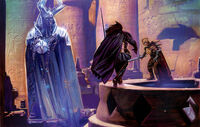
Vitiate chose not to involve himself in the battle for succession between Naga Sadow and Ludo Kressh.
When Ragnos' death in 5000 BBY prompted a struggle to determine who would succeed him, Vitiate chose not to involve himself or his world in the battle between the competing Sith Lords Naga Sadow and Ludo Kressh. Vitiate also refrained from participating in the crusade upon which the victorious Sadow embarked against the Galactic Republic, instead watching from Nathema as the Sith Empire battled the Republic and their Jedi protectors in the Great Hyperspace War. Vitiate had never participated in any battles or conquests during his reign, and had a reputation of being a reclusive scholar. However, when the Empire met its ultimate defeat in battle above the holy tomb world of Korriban, Vitiate put his plans to seize power into action.[1]
Broadcasting speeches across the Empire[1] in 4999 BBY[2] describing how the Jedi Order would destroy the Empire and massacre its people once they discovered the rest of the Sith, Vitiate stoked the Empire's fears and carefully drove the people into a panic[1]—a sensation that only increased when the Republic began to invade the Empire and massacred any Sith they could find[8] on the orders of Supreme Chancellor Pultimo.[9] Assuming a leadership role, Vitiate called all remaining Sith Lords to Nathema in order to aid him in performing a ritual, promising them that it would unleash the full power of the dark side beyond anything they could possibly imagine. At the same time, Vitiate's historians and scientists searched for the location of Dromund Kaas, one of the Empire's original colonies.[1]
Just before the other Sith Lords arrived, the researchers finally succeeded in theorizing a new hyperspace route that led back to Dromund Kaas but also prevented the Jedi from following. Three days after the lead researcher presented the team's findings, Vitiate announced the commencement of his ritual.[1] But when the eight thousand Sith who answered Vitiate's call[10] arrived at his palace, he dominated their minds and bound their wills to his, forcing the Sith to participate in the ritual.[1] The ritual itself took ten days to perform,[2] with the entire planet frozen in the grip of the dark side sorcery, and upon its completion all life on the surface of Nathema was annihilated save for Vitiate. The man absorbed the life force of the entire world, stripping the Force from the very fabric of reality on Nathema and gaining both unimaginable power and immortality as a result. At that moment, the man shed his identity as Lord Vitiate and became simply the Emperor, a figure of immense power and wisdom in the eyes of his fellow Sith.[1]
Hidden empire
Rebuilding an empire
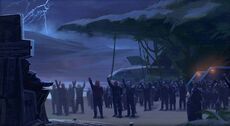
The Sith Emperor speaks to his people upon arriving on Dromund Kaas.
- "If the Jedi know we exist, they will come for us. They will try to finish the extermination of our species that began in the Great Hyperspace War!"
- ―Lord Scourge, expressing the fear that the Emperor had imbued in his people even 1,000 years after the war
Blaming the destruction of Nathema on the Jedi,[1] the self-declared Emperor[10] drove the people of the Empire further into a panic while simultaneously offering them hope. Traveling to Korriban, he promised to lead his people to salvation and safety from the Jedi, and he soon led a great exodus from the Sith Worlds into the Unknown Regions of the galaxy. Despite knowing the location of Dromund Kaas, the Emperor led his people in a series of blind hyperspace jumps,[1] causing the exodus to last for twenty years[11] while the Sith people became more and more dependent on his guidance.[1] Finally, in 4980 BBY,[11] a scout vessel under orders of the Emperor located Dromund Kaas. When the vessel returned to the Sith fleet,[12] the Emperor led his people to the long-lost world, and upon reaching the surface he addressed the Sith.[13] Amidst the wild jungles of Dromund Kaas, he declared a new Empire that would rise from the ashes of the old,[14] and offered both the Sith people and their non-Sith servants the chance to build an orderly and powerful society: an Empire that would one day return and gain their revenge upon the Republic.[13]
The people, who had come to see the Emperor as a kind of god, fervently agreed and set to work building their new Empire.[1] At first, the Emperor appeared in public often and dictated much of the Empire's policies and actions, but over time he began to appear less and less. Not long after arriving on Dromund Kaas, he created the Dark Council—a group of twelve Sith Lords who served as the primary ruling body of the Empire—and the council soon began to take over much of the day-to-day running of the Empire. The Emperor himself retreated into seclusion in the newly constructed Imperial Citadel situated in the heart of Kaas City.[14] One of his first actions was to select twelve Force-sensitive pureblood Sith to become his Hand: twelve Servants who shared their master's longevity in exchange for allowing him to draw on their strength in order to sustain his powers. The Hand's leader, Servant One, was the first to be bound to the Emperor, while his constant companion Servant Two gained prophetic powers through a close connection to the Emperor's mind at the expense of his own sanity. The shadowy organization was known only to a few members of the Dark Council throughout the centuries, as they operated from obscurity to fulfill their master's will.[2]
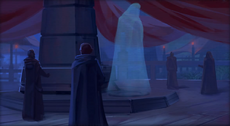
The Dark Council handled the day-to-day running of the Empire, but ultimately answered to the Emperor.
The Emperor spent that time studying even further into the mysteries of the Force, unlocking powerful secrets of the dark side.[15] In the early years after the arrival on Dromund Kaas,[16] the Emperor ordered the expansion of the edifice known as the Dark Temple on the outskirts of Kaas City.[15] An ancient structure that contained the tombs of pre–Hyperspace War Sith Lords such as Aloysius Kallig,[17] the Temple was originally intended as a burial place for the Emperor's enemies, but the Emperor performed powerful dark side rituals to steal the knowledge and life essences of his enemies in the structure's depths and transformed the area into a nexus of dark Force energy.[15] Those rituals soon also affected Dromund Kaas's atmosphere, causing the skies to be filled with perpetual rain storms and lightning.[13] One of the Sithspawn created during the rituals escaped deep underground, becoming known as Akure, the Ghost in the Darkness.[18] The Emperor also maintained chambers within the Sith Sanctum, the headquarters of the Sith Order in the Imperial Citadel, though only the Dark Council and the Emperor's personal guard were allowed into the lower levels of the Sanctum.[19]
The Imperial Guard, as those elite warriors who served the Emperor were called, were a group of non–Force-sensitives who served the Emperor with fanatic loyalty and unmatched combat prowess.[20] Each member of the Guard was brought before the Emperor himself and bound to his will, making their loyalty absolute. Moreover, the Guard answered only to the Emperor—the Dark Council had no control over the group's activities, despite the Guard's roles as protectors of the Sith Sanctum. Once the Empire reclaimed the Sith Academy on Korriban over a thousand years later, the Guard also took on the role of guardians for the Academy.[20] Sometime during his reign, the Emperor also ordered the construction of a personal space station in orbit of Dromund Kaas, which he used as a temple fortress for meditation and experimenting with the dark side.[21]
Around 4606 BBY, a Sith named Kel'eth Ur began to preach Jedi sentiments of peace and serenity while also utilizing the dark side, but the Emperor personally killed the heretic and sealed his spirit in the Dark Temple—a fate that befell many of the Emperor's enemies.[22] Another Sith Lord named Vodal Kressh attempted to challenge the Emperor's rule less than four centuries after the Great Hyperspace War, breeding a race of slaves to serve as an army on the planet Athiss. However, Kressh's plans never advanced beyond Athiss, and when the mad Sith died, the Emperor declared Athiss forbidden.[23] Several centuries into the Emperor's reign, a Dark Councilor named Darth Lokess summoned her fellow Council members to a secret meeting in the midst of a violent storm. With an army of loyal Sith outside of the meeting ready to kill any Dark Councilor who refused, Lokess described a plot to overthrow the Emperor and lead the Empire into war against the Republic once more—a plot that all eleven Councilors agreed to join. However, the Emperor learned of the Council's conspiracy and allowed their plans to unfold, but when the twelve ascended the steps of the Citadel to confront him the Emperor delivered his punishment. Lokess' eleven co-conspirators died in a flash of light on the Citadel steps, and Lokess disappeared forever into the bowels of the structure as the Emperor tortured and then finally killed her.[2]

The Emperor delivers his orders to the Dark Council via hologram.
During the Emperor's reign, six Sith Lords—Raptus, Bestia, Brontes, Calphayus, Styrak, and Tyrans—meditated together and developed a powerful variation of battle meditation that allowed them to induce fear in entire armies.[24] When Bestia approached the Emperor to share their insights,[2] he conferred the title of Dread Master upon her and the others for their abilities, and they went on to serve the Emperor for centuries as prophets, advisors, and generals.[24]
Another one of the Emperor's experiments in the Dark Temple led to the creation of the Ravager, a device that consumed its victims' minds and forced them to reveal their greatest secrets as they died. Not even members of the Dark Council could withstand the Ravager, but the Emperor eventually locked it away in the Dark Temple with other experiments both failed and successful.[25] The Dark Temple itself was sealed after a few centuries and remained so for most of the Emperor's reign. Yet, when Kaas City's power grid was expanded into the tunnels beneath the Temple, devices such as the Ravager that were stored in the Temple had the unintentional effect of driving thousands of slaves mad.[15]
Testing the Republic
- "They tricked me. We were never meant to win this war. They used me and my people to test the Republic's strength."
"Who used you?"
"The Sith." - ―Mandalore the Ultimate tells Revan of the Empire with his dying words
At the founding of his Empire, the Emperor had promised to return and destroy the Republic, but over time that goal grew less important to the people of the Empire. However, the Emperor still planned to invade—but for reasons beyond revenge.[1] In his studies, he discovered a way to magnify the ritual he had performed on Nathema so that it would affect the entire galaxy, and he intended to use war with the Republic as a way to fuel that ritual.[26] Around 4043 BBY,[27] the Dark Councilors Darth Qalar and Darth Victun[2] fought a vicious Kaggath, a Sith ritual duel, that tore apart the Imperial Citadel. When the dust settled, the two were still standing, but the other ten members of the Council combined their powers to obliterate the two.[27] The Emperor surprised the Dark Council by emerging from seclusion and contributed to the designs for the new Citadel, charging the Sith Lord Darth Nostrem with completing the building exactly as the plans specified. After the Citadel's completion, the Emperor locked Nostrem in the depths of the Citadel to test the structure's labyrinthine defenses, and was gratified when the Sith Lord perished, unable to find an exit.[2]
Mandalore the Ultimate, the Emperor's unknowing pawn
A few decades later, several members of the Dark Council discovered Nathema and learned what the Emperor was truly planning. Those Dark Councilors, among them Darth Nyriss and Darth Xedrix, began a conspiracy to unseat the Emperor and save their Empire and the galaxy from annihilation.[1] Not long afterward, around 3978 BBY,[28] the Emperor sent a Sith Pureblood emissary to Mandalore the Ultimate, the leader of the Mandalorian culture of warriors. The emissary explained to Mandalore that his master had driven a Sith Lord named Dramath the Second into exile, and convinced the warrior to help him search for Dramath's tomb on the snowy world of Rekkiad. Breaking into Dramath's crypt and recovering the Sith Lord's remains for his master, the Sith also told Mandalore of a vision that the Emperor had received—one of the Mandalorians crushing the Republic in a glorious victory. However, the Emperor's emissary was also manipulating Mandalore with the power of the dark side, binding the warrior and convincing him to launch a war against the Republic in order to test its strength.[1]
That conflict, which later become known as the Mandalorian Wars, began two years later and raged for a total of sixteen years. The Mandalorians initially had the upper hand until a young Jedi Knight known as Revan took command of the Republic Military with his friend and unofficial apprentice Malak in 3962 BBY. Under Revan's leadership, the Republic gained more and more ground until they finally forced a confrontation at the Battle of Malachor V in 3960 BBY. Revan challenged Mandalore the Ultimate to single combat and won, striking down the warrior just as the Jedi's lieutenant Meetra Surik activated a superweapon known as the Mass Shadow Generator. As Mandalore lay dying, the Emperor's spell was finally broken, and the fallen warrior told his victorious opponent of how he had been manipulated.[1] Revan had already encountered Sith ruins on Korriban and Malachor V before the battle and unknowingly drew the Emperor's attention in the process, and the Emperor reached out to Revan and Malak. Subtly manipulating them,[29] the Emperor watched as the pair retraced Mandalore's steps to Rekkiad and discovered the existence of his Empire.[1]
Examining a datacron belonging to the Emperor's half-brother within Dramath's tomb, Revan and Malak discovered the location of Nathema and traveled to the barren world, where they learned the location of Dromund Kaas itself and witnessed the Emperor's power. Leaving the Republic fleet that they had brought with them, the pair traveled to Dromund Kaas in secret and spent months infiltrating the Imperial Citadel with aid from one of the Imperial Guard—but what they did not suspect was that each member of the Guard was bound to the Emperor's will and would never betray their master. When Revan and Malak finally infiltrated the Emperor's throne room in an attempt to kill him, the Sith dominated their minds just as he had done so many years ago to the Sith Lords on Nathema.[1]
Revan and Malak confront the Emperor.
Breaking their wills, the Emperor forcibly converted the pair to the dark side and declared them Darth Revan and his apprentice, Darth Malak. After prying information about the Republic from their minds, the Emperor sent his new disciples to recover the Star Forge—a space station of unimaginable power constructed by the ancient Rakata—to use in a new war against the Republic. Publicly, the Emperor informed his people that a pair of assassins had attempted to kill him and that they had been executed as a result. However, the newly converted Sith were stronger than he expected, and they broke free of the Emperor's conditioning. Revan decided to declare his own Sith Empire, determined to conquer the Republic and protect it from the Emperor, and proceeded to battle the Republic in what came to be called the Jedi Civil War.[1]
Conspiracies
- "The Emperor used me as his link to the light side of the Force—the Jedi Order. Through me, he saw visions. But that same link also gave me influence. I convinced the Emperor peace was in his best interest. Tempered his hate."
- ―Revan explains how he manipulated the Emperor
Revan was eventually betrayed by his apprentice during a Jedi attempt to capture him, and Malak seized control of their Empire, while Revan's mind was wiped clean by the Jedi Council. Revan went on to destroy the very Empire he had created and defeated Malak aboard the Star Forge, but in the years after the war he began to be plagued by memories of Dromund Kaas. At the same time, the conspirators against the Emperor began to suspect they were on the verge of being discovered. Therefore, Darth Nyriss arranged for several assassination attempts against herself in 3954 BBY as a way of framing the aged Human Darth Xedrix. However, the Emperor interfered with her plans by "suggesting" that she bring in outside assistance in the form of the Sith Lord Scourge.[1]
The Sith Emperor personally intervened in Nyriss' affairs, disrupting her plans.
Nyriss led Scourge through a series of elaborate tests and deceptions as part of his investigations, culminating with Scourge's murder of Xedrix. At that point, Nyriss revealed the conspiracy to Scourge, and in order to convince him to join their cause, she took him to Nathema. However, at the same time Revan had been retracing his steps with the help of his ally Canderous Ordo on Rekkiad. Discovering the existence of the Empire and the location of Nathema, Revan traveled there with his droid companion T3-M4 aboard their ship, the Ebon Hawk. Both Sith and Jedi arrived simultaneously, though Revan did not detect Nyriss' ship at first. The Dark Councilor and Scourge, now entirely believing in the conspiracy's cause, shot down the Ebon Hawk and captured the Jedi Master, whom Nyriss identified as Revan.[1]
Revan was held in captivity by Nyriss for four years, tortured under the direction of Scourge, until Revan's former lieutenant Meetra Surik—better known as the Jedi Exile—followed her friend's trail to Dromund Kaas with T3-M4 in 3950 BBY. Scourge, who had come to trust Revan during the last four years, decided to join forces with him and Surik to destroy the Emperor. As part of their plan, Scourge approached the Emperor and exposed Nyriss' conspiracy, careful to exclude his role in the plot, so that the Emperor would take action against the Dark Councilor. However, the Emperor did not act as Scourge expected: instead of simply eliminating the conspirators, the Emperor decided to purge the entire Dark Council.[1]
The Emperor summoned nine members of the Council, seven of whom were loyal and two who were conspirators, to his chambers in the Citadel and killed them. Only hours later, he dispatched the Imperial Guard to destroy the estates of the three remaining Councilors, whom he had not expected to answer his summons on account of their treachery, with the full force of the Imperial Military. The three members of the Dark Council were caught entirely by surprise, and the Guard decimated their entire power bases as well as the power bases of the other two conspirators. However, Revan was freed by Scourge and Surik during the chaos, and the trio prepared to end the threat that the Emperor posed once and for all. Revan, Scourge, Surik, and T3-M4 infiltrated the Imperial Citadel and fought their way past the Imperial Guard, facing the Emperor himself in his throne room. Revan and his utility droid charged their enemy, causing the Emperor to blast the Jedi Master with the Force. Advancing on his opponent, the Sith attempted to dominate Revan's mind once again, but the Jedi opened himself to both the light and dark sides to unleash the Force in its purest form, an attack that sent the Emperor flying backward.[1]
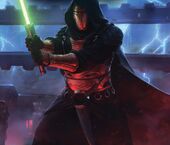
Revan attacks the Emperor.
When Revan attempted to charge the distracted Emperor, the Sith unleashed a blast of Force lightning that sent him screaming to the floor, and blasted T3-M4 into shrapnel when the droid attacked with his flamethrower. Picking up his fallen foe's lightsaber, the Emperor attempted to kill Revan with the weapon but was stopped when Surik knocked it out of the Sith's hands with her own weapon. Faced by Surik, Revan, and Scourge, the Emperor expressed his disappointment with the latter—who was suddenly overcome with visions of the future. Realizing that it was not their destiny to defeat the Emperor, but was in fact the fate of another, Scourge chose to betray his allies by stabbing Surik in the back and distracting Revan enough for the Emperor to blast the Jedi Master with more lightning.[1]
Testing Scourge's loyalty, the Emperor ordered him to kill Revan, but stopped him just before the lightsaber reached its mark. The Emperor decided to imprison Revan, prolonging his life indefinitely through a combination of Sith alchemy and technology, and placing him in a specially constructed prison in the heart of the impossible-to-navigate Maelstrom Nebula. Scourge, who claimed to have deceived the two Jedi in order to bring them before the Emperor, was rewarded with the position of Emperor's Wrath, his personal enforcer, and the same immortality that Revan received. Surik's spirit survived the death of her body, however, and remained faithfully at her friend's side while the Emperor fed off Revan's strength and knowledge. With the strength Surik lent him, Revan was able to fight the Emperor's control and even influence the Emperor in return,[1] tempering the Sith leader's desire to restart war and postponing the renewal of conflict with the Republic for almost three centuries.[30]
Return to the known galaxy
A renewed war
- "The Emperor has manipulated events for centuries toward one goal: performing an even greater ritual that will destroy this galaxy."
- ―Lord Scourge
Despite Revan's influence, the Emperor's will could not be stopped, only slowed. Over the next 200 years, the Emperor advanced his plans for a new invasion. However, Revan's plot and near-successful assassination attempt scared the Emperor immensely, causing him to delve even deeper into his studies of the dark side in search of ways to further guard himself against danger.[2] In his studies, the Emperor discovered the rare technique of essence transfer, which allowed him to prolong his life even further. Using the technique to transfer his life force between bodies, he created the position of Emperor's Voice—the host body of his consciousness and the ultimate extension of his will,[4] which allowed his true immortal body to remain safe and unharmed in hibernation.[31] Throughout the next three centuries, the Emperor utilized many Voices[4] as the ravaging effects of the dark side took their toll upon the host bodies.[32] Those hosts varied widely, including the bodies of a young Human female and an elderly Sith Pureblood, but they always possessed the same emotionless, cold male voice.[4]

The Emperor's Voice during the early Great Galactic War
Meanwhile, the Emperor's plans for war continued. The Force-sensitive Ovair family was installed in the Jedi Order at his request, giving him a family line of Sith spies within the ranks of his enemies. Around 3756 BBY, the Emperor became aware of the tomb of Naga Sadow on the moon of Yavin 4. Viewing Sadow's powers as a potential threat to his planned invasion and his position as ruler of the Sith, the Emperor ordered his agent, Jedi Master Barel Ovair, to eliminate any remnant of the Sith's spirit. Ovair and his Padawan Eison Gynt traveled to the moon on behalf of the Jedi Order with the purpose of ridding it of dark side energies, but the pair were attacked on their mission by the descendants of Sadow's Massassi warriors. Ovair eventually returned to the Republic weeks later without his Padawan, but Sadow possessed Gynt and resurfaced several years later in a failed attempt to kill the undercover Sith. The Jedi historian Gnost-Dural deduced centuries later that Ovair had been in fact been targeted by Sadow's spirit because he was a servant of the Sith Emperor, and that the infiltrator had used Gynt to draw out and eliminate Sadow's spirit before the Empire invaded.[33]
Around the turn of the thirteenth century of his rule, the Emperor became the Sith Master of Exal Kressh, a hybrid Human–Sith descendant of Ludo Kressh.[7] He also began to experiment with learning and combining different Force techniques[34] in an effort to extend his reach and sight beyond the capabilities of his Hand alone.[2] During her apprenticeship, Kressh was sent to a monastery on Ambria, where the Emperor experimented on her and prepared to make her a vessel for his mind.[34] He also spent decades installing infiltrators in positions of power throughout the galaxy.[35] Finally, in 3681 BBY, the Emperor himself announced that the Empire would return to the known galaxy and launch their assault on the Republic.[2] His meticulously calculated plans, in collaboration with the Imperial Military, resulted in a series of victories against the Republic in the Outer Rim Territories, including the successful capture of the Aparo sector[36] following his activation of his agents in the governments of Ruuria, Sernpidal, and Belkadan.[35] As the Imperial Army and Imperial Navy conquered planets such as Sluis Van, Imperial troops massacred anyone who would not swear loyalty to their new Emperor, and troopers of the Republic Military were simply killed on sight.[37]
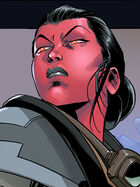
Exal Kressh, the Emperor's apprentice
By the third year of the Great Galactic War, as the conflict soon became known, the Emperor was advancing his plans to spread his influence throughout the galaxy. Through centuries of experimentation, he was developing a combination of mental domination and transference of his consciousness that would allow him create his "Children"—the ultimate agents of his will, as the Children would be extensions of his mind who would only be aware of their true allegiance when he allowed them to be. In the depths of the Sith Academy on the recently reclaimed Korriban, the Emperor's servants were completing the machines and rituals necessary for the process, and his servants were scouring the galaxy for young initiates.[38] To that end, he dispatched Kressh to the ash world of Lenico IV to learn from Ortolan colonists. The colonists' legends spoke of shamans who lived on through their descendants, something that was of interest to the Emperor's plans for his Children.[34]
Massacring the Ortolan colonists on her master's orders after her mission was complete, Kressh returned to the Empire and was sent to the Kathol Rift. However, the Ortolans' stories opened Kressh's eyes, and she realized that the Emperor intended to hollow out her mind and possess her as the first of his Children.[34] Fleeing her duties and traveling into Republic space, she began to feed the Republic information, and then locked herself in stasis aboard the medical space station Colony Blue above Lenico, where the Emperor could only sense her dreams. Not long after her betrayal, the Emperor witnessed a vision of the Sith Lord Nankrang emerging victorious over the Jedi in the Mid Rim, and he personally chose the banner that the Sith Lord's forces would carry into battle.[7]
Desiring to bring his wayward apprentice back under his control, the Emperor ordered the Dark Council to retrieve her, and the Council summoned the Sith apprentice Teneb Kel to Dromund Kaas. There, Kel was brought before the Emperor—whose current Voice was a young Human male—and ordered to find Kressh in the Lenico system.[7] The Sith assassin Kel chased Kressh across the galaxy, encountering her aboard Lenico Colony Blue but failing to capture her until he finally succeeded in killing her in the depths of the Sith Academy on Korriban, where he stopped her from destroying the Emperor's plans. After he learned why Kressh had fled the Emperor, Kel returned to the Council and demanded to be elevated to Lordship in exchange for the information. The Council accepted and granted Kel the title of Darth Thanaton, and in return they learned of the existence of the Children of the Emperor.[38] In revenge for his apprentice's betrayal, the Emperor declared the very name Kressh an abomination and ordered all evidence of the family line across the Empire to be utterly destroyed. The Kressh family was completely obliterated from the entire history and fabric of the Empire, ensuring that the relatives of the Emperor's rebellious apprentice would never rise up against him.[39]
A child is prepared for the Emperor's rituals in the depths of the Sith Academy.
At the orders of the Emperor, Force-sensitive children of many species[40] were taken from their families and entered into a special group at the Sith Academy.[41] Those children came from many different places and backgrounds: Syo Bakarn was a member of a noble house on Corellia,[42] Augin Blaesus was from the Core World of Erigorm,[43] and Kira Carsen was born on Dromund Kaas itself.[41] At different points during their training, each of the children spent weeks undergoing various rituals and processes in the depths of the Academy,[38] culminating in an audience with the Emperor himself where they were infused with the Emperor's strength and bound to his mind and will. Bakarn became the Emperor's First Son, shielding the other Children from detection while also serving on the Jedi High Council, and the Children were sent out into the galaxy as the ultimate undercover agents.[44]
Unless the Emperor willed it, his Children knew nothing of their connection to the Sith or even their Force-sensitivity, and they became high-ranking individuals with influence across the galaxy. Some were planetary representatives,[43] others members of the Republic Military,[45] and some even became members of the Jedi Order itself.[44] Kira Carsen managed to escape Imperial space before the process could be completed when the ten-year-old realized what the Emperor was doing to her, though she would eventually draw the Emperor's attention during her time as a member of the Jedi Order.[41]
As the war continued, the Empire scored victory after victory against an unprepared Republic, claiming worlds such as Utapau and Agamar in their second main offensive.[46] The Imperial capture of the Seswenna sector in 3671 BBY was countered when the Republic won a resounding victory at the First Battle of Bothawui, and the heroic last stand of Jedi Master Belth Allusis and his men at the second battle inspired the Republic to fight back against the seemingly unstoppable Imperial advance.[47] Only a few years later, a Republic strike team led by Jedi Knight Jaric Kaedan captured the Dread Masters, depriving him of his advisors' powerful fear-inducing battle meditation abilities.[37] A further blow to the Imperial war effort came when a much smaller Republic force defeated the Imperial invasion forces at the Battle of Alderaan in 3667 BBY, but the Republic's resurgence was broken with the disastrous naval conflict known as the Battle of Hoth in 3665 BBY.[37]
By 3660 BBY, the Emperor was growing restless, and the breaking of the Imperial-sponsored Mandalorian blockade of the Hydian Way did nothing to help the chances of ending the war.[48] Not long after the blockade, a resilient Republic struck at Ziost itself, although the Empire eventually defeated the attackers in a battle lasting more than a month. The Republic assault was foiled again at the subsequent Battle of Ashas Ree, but the Republic's success at the earlier Battle of Ord Radama angered the Emperor enough to demand that the Empire retake the world. Spurred on by their Lord's command, Lords Darth Malgus and Darth Angral led Imperial forces to a costly victory in the Reconquest of Ord Radama.[35]
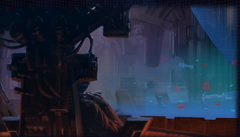
The Great Galactic War marked the first time in centuries that the Emperor personally directed the Empire's actions.
As the war neared the end of its third decade, Revan's influence on the Emperor[30] resulted in something that many Sith found surprising: plans for peace.[49] Both the Emperor and the Dark Council were desperate for an end to the brutal war, which as it dragged on was forcing the Empire to strip entire worlds of their resources and peoples to fuel the Imperial war machine. While some of the seven surviving Dark Councilors wanted to continue the war, the Emperor's plans were put in motion around 3654 BBY after he gave them consolation: each of the seven would receive their own star system from the Republic as part of the upcoming treaty.[50] At the Emperor's request, the Sith Lord Darth Baras led a delegation to approach the Republic with an offer of peace in 3653 BBY. Yet while negotiations were underway on the planet Alderaan, an armada under Darth Angral attacked the Republic capital of Coruscant and held it captive. Using Coruscant as a bargaining chip, the Empire forced the Republic to sign the Treaty of Coruscant and end the Great Galactic War.[49] The Treaty forced the Republic to immediately withdraw all of its military forces from battlefields across the galaxy and redrew the galactic boundaries, effectively granting the Empire control of those parts of the galaxy that lay to the west and north of the Core as well as north of the Corellian Run.[51] However, after the Treaty's completion, the Emperor retreated back into seclusion and left the Empire under the control of the Dark Council.[46]
Cold War
- "I see futures in you. Futures I will not allow. Your future ends here."
- ―The Emperor, to the Jedi Knight later known as the Hero of Tython
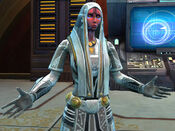
The Emperor took an interest in the Voss after learning of their prophetic abilities.
The signing of the treaty began a period that soon came to be called the Cold War, where both the Empire and the Republic rebuilt their strength and engaged in various minor proxy engagements to test their enemy's readiness. The Emperor retained an iron grip on the hearts and minds of his people despite his seemingly apathetic role in governing them, and the Dark Council continued their typical power plays and maneuvering as they ran the Empire.[52] About four years after the treaty,[53] a new world named Voss was discovered by the Empire, and reports delivered by Darth Baras on the Force-sensitive Voss species intrigued the Emperor.[54] The species was ruled by a group of Mystics whose prophecies were always accurate,[55] and the Emperor desired to have one of them as his Voice. As a result, an Imperial force attacked the planet while the Emperor's Hand kidnapped a Mystic from the surface. The Hand was successful in capturing the Mystic, although the Voss annihilated the attacking force. The Emperor studied his captive's abilities throughout the Cold War, utilizing the Voss's prophetic powers to see visions of the future.[54]
A decade after the Treaty of Coruscant,[3] the former apprentice of Jedi Master Orgus Din drew the ire of Darth Angral when the Jedi Knight killed the Sith's son Tarnis on Coruscant.[56] Driven mad with grief, Angral began to wage war against the Republic using stolen superweapons, which caused the Emperor to take an interest in the subject of Angral's wrath. When Angral encountered the Knight's apprentice Kira Carsen on the planet Ord Mantell, the Sith Lord was surprised to learn that the Padawan was a former Child, and he informed the Emperor almost immediately. Desiring to control Carsen once again, the Emperor sent her former fellow Child Valis to retrieve her.[41]
On the Emperor's orders, Valis lured Carsen and her Master to an abandoned mining facility and battled the pair in an attempt to recapture Carsen.[41] When Carsen and the Knight finally faced Angral aboard his flagship Oppressor, the Emperor chose that moment to take control of her. On the Emperor's orders, Angral battled the Knight to the death, and the Emperor took full control of Carsen when Angral fell to the Jedi's blade. However, with help from her Master, Carsen was able to summon a wall of light to permanently sever her connection to the Emperor.[57] The loss of Carsen angered the Emperor, but he soon became suspicious of the Knight, who became known as the Hero of Tython after the battle with Angral,[57] and grew wary of the Jedi's power[58] over the next year.[3]
A new war
The Jedi threat
The Emperor's ancient space station above Dromund Kaas
- "You are mine. Servants. Slaves. Weapons. And you will obey…"
- ―The Emperor takes control of the Jedi strike team
In 3642 BBY,[59] the tenuous peace brought by the Treaty of Coruscant began to collapse as a result of various proxy conflicts, Angral's campaign among them.[57] However, the Empire did not truly commit itself to a renewed war until the Emperor's hold on Revan was broken. The Force ghost of Meetra Surik enlisted the aid of the Jedi Master Oteg and an elite strike team composed of Republic soldiers and Jedi to free the imprisoned Jedi from the heart of the Maelstrom, and for the first time in centuries the Emperor was freed from Revan's mental manipulations—and no longer hindered by Revan's desire to protect the Republic. Without Revan's influence, the Emperor began to accelerate his plans for galactic annihilation and fueled the flames of war across the galaxy, and the Empire began to make war upon the Republic in force.[30] When the Emperor learned that the former Dark Councilor Sajar—now the Padawan of Jedi Master Tol Braga—was on the planet Quesh, the Emperor dispatched his Wrath to capture Sajar.[58]
Lord Scourge failed, however, when he encountered the Hero of Tython and recognized the Jedi as the one he had seen in his visions three hundred years ago. Knowing of the Emperor's interest in the Hero, Scourge returned empty-handed to his master and delivered the news[58] that the Knight had joined a strike team that Tol Braga was assembling—a strike team with the purpose of capturing and redeeming the Emperor.[60] The Emperor sent a detachment of the Imperial Guard, under the command of Guardsman Lassicar,[61] to follow the Jedi to the planet Hoth, and Lassicar soon reported that the strike team intended to infiltrate the Emperor's space station.[60] On Balmorra, the Hero and Jedi Master Warren Sedoru had already recovered the prototype of the cloaking device shielding the fortress,[62] and Lassicar's men failed in their attempts to capture the Hero and prevent the acquisition of the fortress' schematics on Hoth.[63] The Emperor also activated one of his Children, Augin Blaesus, in an attempt to kill the royal family of Erigorm—an action that would have severely damaged the Republic's relationship with the Rift Alliance splinter government and harmed the Republic's war effort—but Blaesus' efforts were foiled by the Jedi Master known as the Barsen'thor.[43]
When the strike team landed aboard the Emperor's fortress, they were forced to fight through the Imperial Guard—as well as Sithspawn known as Harrowers—to reach the Emperor, and the first Jedi to enter the Emperor's throne room were the Hero and Kira Carsen. While the Emperor watched from his throne, Scourge battled the pair in a fierce duel, but the Wrath was ultimately defeated by the two Jedi. At that moment, Braga, Sedoru, and the Jedi Knight Leeha Narezz arrived in the throne room, and Braga approached the Emperor's throne to request that he accompany the Jedi back to Tython. Leaping down from his throne, the Emperor mocked the Jedi Master for his pride and self-righteousness, surprising the strike team with his knowledge of their identities.[64]
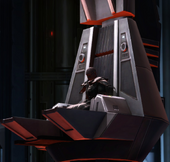
The Emperor easily overpowered Master Braga's strike team.
The Emperor let loose a blazing storm of violet lightning that sent Narezz and Sedoru crashing to the floor while Braga, Carsen, and the Hero struggled to deflect it. It was not long before Braga and then Carsen succumbed to the Emperor's attack as well, leaving only the Knight to advance slowly against the storm. The Emperor then summoned a ball of Force lightning in his hands and unleashed his full power against the Hero, throwing the Jedi to the floor as the Emperor began to dominate the minds of his fallen enemies. Informing them that they were now his slaves and weapons, he unleashed another blast of lightning that sent them all into unconsciousness.[64]
True to his word, the Emperor bound the Jedi to his will and turned them to the dark side. His servants spent several months retraining them as Sith, transforming the fallen Jedi into the Emperor's loyal agents, and the Hero was placed under the tutelage of Overseer Chaskar. However, the Knight was finally freed from the Emperor's control by the spirit of Orgus Din, and the Hero escaped back to Tython with the help of Scourge. The former Emperor's Wrath revealed to the Jedi Council that the Emperor intended to complete the life-consuming ritual again on a galactic scale, but the ritual required a sacrifice of billions of simultaneous deaths to start.[26] To that end, the Emperor sent the high-ranking Executor Krannus and his death cult to the recently discovered Republic prison world of Belsavis. Knowing that the fanatically loyal cult would gladly sacrifice their lives for him, the Emperor orchestrated an Imperial attack to serve as a distraction[65] so that Krannus could detonate the planet's power core; the resulting explosion would ripple through hyperspace and consume all of the neighboring systems.[66] The Emperor also awoke S. Geland, a Child who was on Belsavis, in order to prevent the Barsen'thor from acquiring an army in the form of the Esh-kha species.[67]
Voices and pawns
- "These petty conflicts mean nothing. The concerns of this galaxy are meaningless. Once I ascend, all will be tranquil in this galaxy. It is my promise to you. Now, strike!"
- ―The Emperor orders his Wrath to kill the Voice and free his essence
While the Hero and Scourge rushed to Belsavis, the Emperor was baited into traveling to the planet Voss by Darth Baras. Baras had alerted his leader to the presence of a dark side entity known as Sel-Makor on Voss, and the Emperor traveled there to see if Sel-Makor's secrets could aid him in completing the ritual.[54] However, Baras was manipulating the Emperor—when the Voss body that the Emperor was occupying entered Sel-Makor's resting place in the ancient Sith ruins known as the Dark Heart, the Emperor discovered that he could not leave. Sel-Makor began to fight the Emperor for control of the Voice, silencing the Emperor and cutting him off from the Hand.[68]
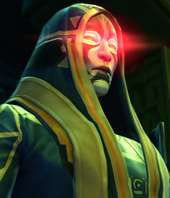
During the Cold War, the Emperor utilized a Voss Mystic as his Voice.
The Emperor's last instruction was for the Hand to recruit the apprentice of Darth Baras as his new Wrath. Baras' apprentice had been betrayed by the Sith Lord on the planet Quesh,[69] and the Hand sent the new Wrath to eliminate Baras' sister Darth Ekkage before she could escape her prison on Belsavis.[70] In a moment of strength, the Emperor was able to send a message to the Hand that explained his predicament.[54] As a result, the Emperor's Wrath was able to locate him in the Dark Heart, and after driving Sel-Makor from the Emperor's host, the Wrath fulfilled the Emperor's request and killed the Voice.[68] That allowed the essence of the Emperor to return to his Hand, who aided their master in inhabiting the body of a Human male.[71]
One of the Emperor's first actions after being freed was to send the Sith Lord Fulminiss, a renowned Sith sorcerer who excelled at mass extinction through Sith magic, to Voss so that he could start the ritual.[72] On the Emperor's orders, the fallen Narezz set a trap for the Hero of Tython using her lover Jomar Chul on the Korriban's Flame space station, but the Hero was able to defeat the Nautolan Jedi and break the Emperor's control over her.[73] Through the eyes of another Child named Sophia Farash, the Emperor learned that the Barsen'thor was securing the aid of the Voss species, but Farash's attempt to kill the Jedi Master ended with the Child's death.[74]
The Hero also succeeded in halting Fulminiss' plans on Voss, preventing the Sith from using Sel-Makor to unleash a plague of madness across the planet,[75] and defeated Warren Sedoru after the fallen Jedi Master captured the Republic flagship Valiant.[76] Unconcerned with the recent losses, the Emperor dispatched Tol Braga to the embattled world of Corellia, where the Kel Dor Dark Jedi began to aid the Imperial military in the Battle of Corellia. However, Braga's true assignment was to cause massive civilian casualties in order to start the Emperor's ritual, and the Jedi Order soon marshaled all available Jedi and placed them under the Hero's command on Corellia to combat Braga's plans.[77] Upon learning from his First Son that the Jedi had entrusted the Guardian Holds, several vital fortresses on Corellia, to his unknowing Children, the Emperor also activated those Children in order to take control of the Holds and damage the Republic's war efforts on Corellia.[78]
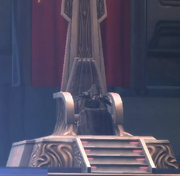
The Emperor was seemingly unconcerned when the Hero of Tython managed to foil his plans across the galaxy.
After the Hero's forces foiled Braga's attempts to massacre civilians,[79][80] the Emperor ordered the Kel Dor to detonate the Imperial battle cruiser Eclipse above the Government District of Corellia's Coronet City. The corrupted Jedi Master—who had long ago accepted his fate and now served the Emperor willingly—complied with his master's instructions, but the Hero of Tython boarded the cruiser and managed to disable the ship's engines before detonation. In the process, the Knight also defeated Braga and managed to draw him back to the light side after refusing to end the Jedi Master's suffering.[81] The Emperor was further weakened by the loss of his First Son, who was defeated by the Barsen'thor before Bakarn purged the First Son from his own mind. With the First Son's defeat, the shroud protecting the other Children from detection was lifted, allowing the Jedi Order to track down the Emperor's entire network of spies.[44]
Final confrontation
- "I will not be contained. I cannot be redeemed. Death is all that remains, and you will not kill me. […] I will not be your trophy. If I must die, I choose how—and everything dies with me."
- ―The Emperor's last words to the Hero
After learning of the Emperor's location on Dromund Kaas from Braga,[81] the Hero embarked on a mission to confront the Sith in the Dark Temple, while an invasion force under the command of Grand Master Satele Shan attacked the Imperial capital. Well aware of his enemy's presence and intention, the Emperor waited in the depths of the Dark Temple as the Hero and the astromech droid T7-O1 fought their way through the Imperial military and the Temple's defenses. As a droid, T7-O1 was the only one of the Jedi's companions who could safely confront the Emperor without falling under the Sith's control, but the Hero and T7-O1 were forced to rescue one of the other members of their crew when the companion was pinned down by Imperial forces.[71]
When his enemies arrived in the Dark Temple's throne room, the Emperor arose from his throne and unleashed a bolt of violet lightning after mocking the Jedi for sacrificing strength to rescue an ally. The Hero intercepted the attack with a lightsaber, and the Emperor summoned three mindform duplicates of himself to attack the Knight as he slowly descended the steps from his throne. The Jedi and T7-O1 made quick work of the phantoms by the time he reached the bottom, and the Emperor remained unfazed when his opponent's weapon was raised in a guard stance. The Hero questioned the Sith's desire to consume the galaxy, but the Emperor warned the Knight that his mind and abilities were beyond the Jedi's comprehension, and his goals were his to decide.[71]
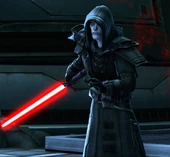
One of the Emperor's duplicates charges the Hero.
Claiming that he would outlast everything and that his will could not be stopped, the Emperor summoned more duplicates of himself and drew his own lightsaber. Both the Emperor and his phantoms utilized Sith magic and lightning as they battled the Hero and T7-O1, vanishing and reappearing within the dimly lit chamber to toy with his opponent's senses. But to the Emperor's surprise, the Jedi slowly but surely gained the upper hand in their battle, cutting down the duplicates one by one and battering away at the Emperor's defenses. Finally, the phantom Emperors dissolved into swirls of dark side energy, and the Hero's true opponent fell to his knees before the steps. However, when the Knight approached the seemingly injured Emperor, the Sith unleashed an explosive blast of Force lightning that sent his opponent sliding back across the floor.[71]
The Emperor acknowledged his enemy's immense power, but mocked the Jedi's limiting adherence to the light side of the Force before unleashing a second, more powerful blast of lightning. The Hero managed to catch the attack on the blade of a lightsaber, and the two opponents advanced across the room toward each other as the Emperor continued to blast the Jedi with lightning. As they reached each other, the Knight spun to the side and delivered a devastating strike to the Emperor's waist. The Sith fell to the floor, but lightning continued to crackle around him as he tried and failed to rise, and he defiantly declared that he would never be redeemed or contained. Brushing off the Hero's claims that he would face justice, the Emperor again attempted and failed to rise to his feet. Under the belief that the Emperor was dead, the Jedi contacted Lord Scourge to report success, and the former Emperor's Wrath informed his ally that the Emperor was not yet defeated.[71]
The Emperor's essence left his fallen Voice and warned the Hero that he would take the Jedi with him if he had to die, releasing a massive amount of dark side energy from the body of the Voice as a final defiant act. The energy rippled through the Dark Temple and began to collapse the structure, so the Jedi and T7-O1 fled the structure and returned to their ship.[71]
A restless sleep
- "He's gone. Everyone knows that. But his voice… still in my head. Can't sleep. Nothing makes sense. The Emperor is dead. Why is he still talking?"
- ―Suri
The Emperor's essence outlived his host and returned to his true body.
The Emperor's essence returned to his true body and entered a deep slumber in order to recuperate, as the battle with the Hero had grievously wounded his spirit.[31] Yet the rest of the Empire believed that their leader had fallen. Darth Malgus took advantage of his absence to steal the Emperor's space station and declare his own New Empire, though the false Emperor would be defeated in battle with both Republic and Imperial forces on Ilum.[82] While his Hand tended to and guarded his body, the Emperor slowly recovered from the devastating injury that the Hero had dealt him by killing the Voice.[83] In his slumber, the Emperor's injured mind reached out to his Children and began to whisper to them, raging at the Knight and issuing contradictory orders as his consciousness moved quickly from thought to thought. Some Children, such as Tannac, were able to block out the incoherent commands of their master, but others like Suri were almost driven mad by his rage and constantly shifting thoughts.[84]
However, without the Emperor's commands directing their actions, the Dread Masters[85]—who had recently been freed from their prison on Belsavis[86] after twenty-seven years of confinement[37]—decided to become independent, as they considered the Emperor as the only one worthy of their loyalty. Manipulating the Trandoshan warlord Kephess on Denova as well as other events across the galaxy, the six turned against both the Empire and the Republic to become a third power in the new war.[85] During that time, the Emperor's Hand was instructed to appoint Darth Acina as the successor to Darth Karrid, the head of the Sphere of Technology, and Acina was ordered by the Hand to oversee the Arcanum—the Emperor's storehouse of powerful Sith artifacts.[87]
Legacy
- "When I was born, the Emperor was the Empire. Everything existed to feed his whims. He was so far above us. No one, Sith or slave, would have dared even form an opinion about him."
- ―Lord Scourge
The Emperor ruled the Empire for over 1300 years, and during that time he exerted an enormous psychological influence on his people. In the Empire, he was viewed as both a god and king—almost every citizen of the Empire was more than willing to sacrifice his or her life in the service of their Emperor. He was the source of many common phrases and utterances in Imperial culture, such as "Glory to the Emperor,"[88] "Long Live the Emperor,"[89] and "It's enough to wake the Emperor."[90]
Eventually, the Emperor passed away, and thousands of years later, the Sith Lord Darth Plagueis—himself obsessed with achieving immortality—mused that Emperor Vitiate, as he was known to history, was the only Sith Lord in history who had come close to achieving the secret.[5]
Personality and traits
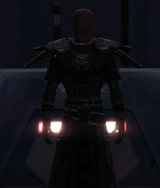
The Sith Emperor desired the complete annihilation of all life in the galaxy.
- "If you kill everyone in the galaxy, you'll be Emperor of nothing. What's the point of all this?"
"You discern a fraction of reality. Beyond these stars exist other galaxies, other worlds, other beings. I will experience or ignore them as I wish. I will spend eternity becoming everything: a farmer, an artist, a simple man. When the last living thing in the universe finally dies, I will enjoy peace and wait for the cycle to begin again." - ―The Hero of Tython and the Emperor
Almost from birth, the Emperor was unusual in that he seemed to lack emotion and empathy[1]—something that would remain constant throughout his life, regardless of the host body he would use.[4] The child Tenebrae felt no affection for his mother, stepfather, or birth father, as he killed each of them without mercy, and it was not long after his powers manifested that he discovered how to feed off the fear and suffering of those around him. As a child, he was a cruel ruler, massacring hundreds simply to sate his hunger for anguish. As a Sith Lord, Vitiate became known as more of a scholar than a warrior, as he spent much of his century-long rule delving into the mysteries of the dark side.[1]
While other Sith became feared warriors and conquered new worlds for the glory of the Empire, Vitiate was content to remain on Nathema even when the rest of the Sith Lords went to war against the Republic. However, his public persona of a scholar was merely a sham: by the time he entered the second century of his lifetime, he was calculating, manipulative, and patient enough to sit by while his plans took years to reach completion. When news of Naga Sadow's defeat reached the ears of the people, Vitiate was able to carefully drive the rest of the Empire into a frenzy of panic and herd them as he wished. He also revealed his true persona to the eight thousand Sith Lords who heeded his call on Nathema—the reclusive scholar crushed their minds and bound them to his own indomitable will.[1]
The ritual performed on Nathema affected the Emperor beyond just his strength in the Force; the price of immortality meant that he no longer experienced any of the senses that normal people possessed. Taste, touch, smell, color, and even emotion meant nothing to him, as he lacked the capacity to experience any of them. He did not care, however, as such mortal concerns were now beneath him.[91] His servant Lord Scourge, whom he subjected to a scientific recreation of his immortality ritual,[92] came to realize during his three centuries of service that the Sith ruler had transcended his humanity and mortality even within his own mind—the Emperor sacrificed the ability to feel anything, separating himself from the rest of the universe in the most fundamental ways and convincing himself that he was like a god.[91]
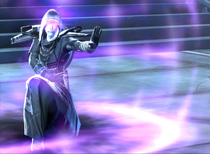
The Emperor was determined not to die, regardless of the consequences to the rest of the galaxy.
In his search for a way to completely escape death, the one thing he truly feared,[93] the Emperor delved into many arcane and lost techniques of the dark side. Developing ways to link his consciousness with those of other beings, he soon gained a significant number of servants who were fanatically loyal to and intricately linked with their master.[1] As the reach of his consciousness grew ever greater, he became capable of dividing his focus among multiple agents of his will across the galaxy[38][57] while still maintaining complete possession of his current Voice.[4] Because of that ability, those who received audiences with the Emperor often gained the correct impression that the Sith was listening to other conversations even while speaking.[4]
The Emperor was motivated by the only two emotions he could still feel:[91] hunger for power[1] and fear of losing it.[93] Revan's subconscious manipulations of the Emperor while he was imprisoned further augmented the Sith's fear of death, pushing it to the point of irrationality and fueling his desire to become truly and utterly immortal.[1] As his spirit had been rendered immortal by the ritual, his perception of time and his patience extended as well[91]—something that allowed him to carefully work for centuries toward his goals.[33][35] The hopes, desires, and concerns of living beings meant nothing to him,[92] and to him all other beings were like ants; his will was utter and absolute. If the Emperor's ritual had been completed, the Sith would have spent eternity fulfilling any desire that he had. Over the course of his life, he came to desire peace for the galaxy, but peace in the form of utter and complete emptiness.[71] When he touched Scourge with his mind, the mental contact drove the Sith Lord nearly insane despite only lasting less than a second. Scourge's perception of the Emperor's mind was one filled with indescribable horrors, with the emptiness of complete annihilation lurking beneath its surface.[1]
When the Hero of Tython began to oppose him, the Emperor professed a lack of concern for the Knight's successes against his agents,[64] but over the course of his service, Scourge had come to recognize what little emotion remained in his master, and that the emotions that the Emperor was feeling were fear and hatred.[26] Using the powers of Revan[30] and his Voss host[68] to gaze into the future, the Emperor saw the possibility[57] of his own death at the hands of that Jedi.[26] That threat terrified the immortal ruler, and he became more and more anxious to complete the dark ritual again to ensure his survival, but the Hero was ultimately able to strike down the Emperor in battle just as he had foreseen.[71] Even then, the Emperor clung to life as a spirit of the dark side and took control of a new host,[31] but he eventually died a final death some time over the course of the next three thousand years.[5]
Powers and abilities
The Emperor gathers a storm of dark side energy before releasing it as Force lightning.
- "There is no death; there is only the Force—and I am its master."
- ―The Sith Emperor
Even as a child, the Sith Emperor possessed immense strength in the Force, and his abilities began to manifest themselves at the age of six. He used his newfound powers to snap his adoptive father's neck with a thought, and tortured his mother with the Force for months while feeding on her fear and pain. As his powers grew, Tenebrae continued to gorge himself on the fear and suffering of those whom he tortured in public executions. When he confronted his real father, the Sith Lord Dramath, at the age of ten, Tenebrae was able to strip the man of both his sanity and his power in the Force.[1]
Tenebrae's power at the age of thirteen was great enough for Marka Ragnos, the current Dark Lord of the Sith, to acknowledge the teenager's strength and grant him the title of Lord Vitiate. Vitiate soon gained a reputation as a scholar, spending much of the next century studying the secrets of the dark side. He soon gained an immense knowledge of Sith sorcery, becoming one of the most powerful practitioners of both Sith magic and alchemy throughout history, and devised complex rituals to warp reality and life itself. Another one of Vitiate's specialties was in the domination of his opponent's minds, as he was able to dominate the minds of eight thousand Sith Lords and bind them to his will. He then used their combined power to perform the most complex ritual of Sith magic ever performed, ripping the Force from the entire planet of Nathema and absorbing the combined life force of every living thing on the surface. Lord Scourge suspected that the Emperor had not only absorbed the lives of those who had died in the ritual, but was in fact feeding off their spirits to sustain his own throughout the centuries that followed.[1]
As Emperor, he spent much of his rule experimenting even further with the dark side, discovering many lost techniques and increasing his immense power even more.[13] While his body was harmed by the ravaging effects of the dark side, the technique of transfer essence allowed him to move his consciousness, which had been made immortal as a result of the ritual on Nathema, between bodies and sustain his life indefinitely.[4] By combining various Force techniques, the Emperor was also able to imbue portions of his consciousness into infants, transforming those Children of the Emperor into extensions of his will. He could suppress his Children's personas and even their Force-sensitivity, making them the ultimate covert operatives, and further possess them like puppets.[40]
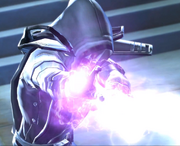
The Emperor made extensive use of Force lightning during combat.
The Emperor's rituals on Dromund Kaas warped the planet's very atmosphere, creating perpetual lightning storms,[13] and he became a master of manipulating objects and the environment with the Force. He was easily able to block T3-M4's flamethrower by wrapping the Force around himself, and could send Revan flying across his throne room with barely an effort. The Emperor could conjure storms of Force lightning, and he disintegrated T3-M4 with just a thought by blasting the astromech droid into shrapnel.[1] The Emperor was able to summon Sith magic, which enabled him to create physical duplicates of himself while battling the Hero of Tython. When necessary, the Emperor would utilize his red-bladed lightsaber in combat.[71]
Behind the scenes
- "All Sith have a fatal flaw: an overwhelming emotion that drives them to self-destruction. For the Emperor, that emotion is fear."
- ―Senior writer Hall Hood
The Sith Emperor and his Empire were first mentioned, albeit indirectly, in the 2004 video game Star Wars: Knights of the Old Republic II: The Sith Lords as the mysterious threat that Revan had left to confront after the end of the previous game, Star Wars: Knights of the Old Republic.[94] His first true appearance was in Star Wars: The Old Republic, Blood of the Empire Act 1: Shades of the Sith, an issue in the 2010 Star Wars: The Old Republic series of comics that served as backstory for the 2011 massively multiplayer online role-playing game Star Wars: The Old Republic.[7] He appeared repeatedly in the Galactic Timeline series of in-universe history videos, which explained the history of the Great Galactic War as well as the history of the reconstituted Sith Empire,[14][33] and is also mentioned on several pages of the Holonet division of the game's official site.[46][95][96]
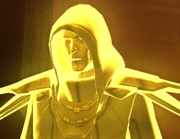
The Emperor in a vision to Jedi Knight players, during the optional quest "The Trials" on Voss
When The Old Republic was first announced in 2008, the entertainment site IGN mistakenly reported that the identity of the Sith Emperor was actually Naga Sadow,[97] though the official website was more vague on the subject.[46] Comments by Daniel Erickson, one of the lead writers for the game, led many to believe that the Emperor had in fact been Emperor during the Great Hyperspace War,[98] though this was later debunked and the Emperor's backstory explained in the 2011 novel The Old Republic: Revan. Written by Drew Karpyshyn, the book revealed the Emperor had been born Tenebrae on the planet Medriaas, and explained both Tenebrae's rise to power as Lord Vitiate and the origins of Vitiate's Empire itself.[1] The 2012 reference guide Star Wars: The Old Republic Encyclopedia gave further information on the Sith Emperor, revealing that the position of Emperor's Voice and the creation of the Children were results of Revan's attack on the Emperor. It also gave more information on the early Empire, though it also referred to him as "Darth Vitiate"—however, the Encyclopedia was also incorrect on several other details.[2] Jason Fry similarly applied the title of Darth to Naga Sadow in his 2012 guide book The Essential Guide to Warfare, though he confirmed that it was not intended.[99] The rest of the Encyclopedia refers to the Emperor only as "Lord Vitiate" in the few places it uses the name, so it is unclear if the use of the Darth title was simply an error.[2] 2012's The Essential Reader's Companion mistakenly stated that the Emperor was Human,[100] though Drew Karpysyshyn confirmed that the Emperor's original body was that of a pure Sith.[6]
The name "Tenebrae" is Latin for darkness, gloom or obscurity,[101] while his Sith title of Vitiate is also Latin: in this case, it means "having been corrupted, defiled, or voided."[102] The English word vitiate means to spoil, impair, weaken, or corrupt.[103] Daniel Wallace, author of the 2012 reference book Book of Sith: Secrets from the Dark Side, originally planned to have the Sith Emperor author a section of the book, which is represented in-universe by a group of Sith texts compiled by the Sith Lord Darth Sidious. However, the lack of information on the Emperor led Wallace to decide that Darth Malgus would author that section.[104]
While he is mentioned throughout The Old Republic, the Emperor only appears in "person" in the Sith Warrior[68] and Jedi Knight class storylines,[64][71] and is voiced by Doug Bradley,[105] who played the character Pinhead in the Hellraiser movie franchise. Hall Hood, the main writer for the Jedi Knight class, brought up YouTube videos of Bradley's performance as Pinhead when the writers were discussing who they wanted to voice the Emperor, and the team decided on Bradley.[106] He appears in "Descent," the final mission of Act II for the Jedi Knight, where the Knight boards the Emperor's space station. The attempt to capture him fails, and the Emperor turns the player to the dark side in a cutscene.[64] However, the Sith Warrior mission "The Voice of Darkness" on Voss explains the role of the Emperor's Voice, and confirms that the Emperor had been utilizing a Voss Mystic as his Voice throughout the Cold War. In the mission, the player is forced to battle the Emperor's Voice—which had been possessed by Sel-Makor—before killing the Voice and freeing the Emperor's essence.[68] The Emperor can also appear in a vision to Jedi Knight players if they choose to complete the mission "The Trials" on Voss, while players of other classes will receive visions of their enemies taken from their respective finales.[107]

Star Wars: Darth Plagueis confirmed that the Emperor did eventually meet his final death.
The Act III finale of the Jedi Knight storyline features a final confrontation with the Emperor on Dromund Kaas, where the Knight fights through the Dark Temple to reach him. When one of the player's companions is under attack, the player can choose to rescue their companion for light side points, at the cost of giving the Emperor time to "increase" his strength. Alternatively, they can choose to leave their companion to die for dark side points, but the Emperor remains the same in terms of game mechanics either way. After the Emperor is defeated, the player is presented with two light side options and a dark side option: tell the Emperor that he will face justice, promise the Sith that he will be redeemed, or simply kill the Emperor. The first two options give light side points, but the Emperor still collapses and seemingly dies before exploding into dark side energy after the player speaks with Lord Scourge.[71]
The Emperor's Voice dies as a result of the collapsing building and wounds inflicted by the Knight,[71] but it is revealed in a message to Sith Warrior players that the Emperor's essence survived and returned to another body, where he entered a deep sleep under the care of his Hand to recover his strength.[31] However, the 2012 novel Darth Plagueis reveals that the Sith Emperor did in fact die a final time at some point before the book's events, 3,600 years after the events of The Old Republic. In the novel, which explains the backstories of the Sith Lords Darth Plagueis and Darth Sidious, Plagueis muses about Vitiate's accomplishments during the Muun Sith Lord's own research on immortality.[5]
Cut content
Several Codex entries within The Old Republic were present in the beta release of the game, but were cut for unknown reasons. Two of these—"The Phobis Devices" and "Blade of the Sith Executioner"—relate specifically to the Emperor's history.
At some point during his reign, the Emperor also discovered the three Phobis devices—powerful Sith artifacts that allowed their users to command fear itself. The devices' mere presence was enough to instill crippling fear in the minds of many Sith,[108] and it was not until six Sith Lords—Raptus, Bestia, Brontes, Calphayus, Styrak, and Tyrans—meditated together on the Phobis devices that the power of the artifacts was harnessed.[24] However, the Emperor acknowledged their power as a potential threat, and locked one of three Phobis devices—the Phobis Core—away in the depths of the Dark Temple as a way of limiting the six's powers.[108]
The Sith Lord Koval Renge served as the Emperor's personal enforcer during his lifetime, utilizing his ceremonial executioner's blade to dispatch hundreds of his master's enemies. Renge, who was granted the title of Sith Executioner, eventually became fearful of his master's continually increasing power, and his attempt at betrayal was foiled—the Sith Lord's own blade was turned on Renge, striking him in the chest and breaking off. A splinter of the blade was left in Renge's body after the Emperor ordered the healing of his wounds, and the former Executioner was then cast into the Dark Temple as the ultimate punishment.[109]
Appearances
- The Old Republic: Revan (First identified as Tenebrae and Vitiate)
- Star Wars: Knights of the Old Republic II: The Sith Lords (First mentioned) (Indirect mention only) (Retcon)
- Star Wars: The Old Republic, Blood of the Empire Act 1: Shades of the Sith (First appearance)
- Star Wars: The Old Republic, Blood of the Empire Act 2: The Broken World (Mentioned only)
- Star Wars: The Old Republic, Blood of the Empire Act 3: Burn the Future (Mentioned only)
- Star Wars: The Old Republic, Threat of Peace Act 1: Treaty of Coruscant (Mentioned only)
- The Old Republic: Deceived (Mentioned only)
- Timeline 1: Treaty of Coruscant (Mentioned only)
- Timeline 4: The Empire Changes Strategy (Appears in hologram)
- Timeline 5: The Battle of Bothawui (Appears in hologram)
- Timeline 6: Onslaught of the Sith Empire (Appears in hologram)
- Timeline 7: Peace for the Republic? (Mentioned only)
- Timeline 8: The Jedi Civil War (Appears in hologram)
- Timeline 9: The Mandalorian Wars (Appears in hologram)
- Timeline 10: The Exar Kun War (Mentioned only)
- Timeline 11: Rebirth of the Sith Empire (Appears in hologram)
- Timeline 12: The Great Hyperspace War (Appears in hologram)
- The Old Republic: Fatal Alliance (Mentioned only)
- Star Wars: The Old Republic
- Star Wars: The Old Republic 2: The Lost Suns, Part 2 (Mentioned only)
- The Old Republic: Annihilation (Mentioned only)
- Star Wars: The Old Republic: Rise of the Hutt Cartel (Mentioned only)
- Darth Plagueis (Mentioned only)
Sources
 Tinker, Tailor, Soldier, Praji on Hyperspace (article) (content removed from StarWars.com and unavailable)
Tinker, Tailor, Soldier, Praji on Hyperspace (article) (content removed from StarWars.com and unavailable) Sith Empire on The Old Republic Holonet (backup link) (content now obsolete; original version)
Sith Empire on The Old Republic Holonet (backup link) (content now obsolete; original version) Korriban on The Old Republic Holonet (backup link) (content now obsolete; original version)
Korriban on The Old Republic Holonet (backup link) (content now obsolete; original version)- The Essential Atlas (Indirect mention only)
 Dromund Kaas on The Old Republic Holonet (backup link) (content now obsolete; original version)
Dromund Kaas on The Old Republic Holonet (backup link) (content now obsolete; original version) Lord Scourge on The Old Republic Holonet (backup link)
Lord Scourge on The Old Republic Holonet (backup link) Athiss on The Old Republic Holonet (backup link)
Athiss on The Old Republic Holonet (backup link) Boarding Party on The Old Republic Holonet (backup link)
Boarding Party on The Old Republic Holonet (backup link) Taral V on The Old Republic Holonet (backup link)
Taral V on The Old Republic Holonet (backup link) The Red Reaper on The Old Republic Holonet (backup link)
The Red Reaper on The Old Republic Holonet (backup link)- The Art and Making of Star Wars: The Old Republic
- Star Wars: The Old Republic Explorer's Guide: Prima Official Game Guide
- The Journal of Master Gnost-Dural
- Book of Sith: Secrets from the Dark Side
- Star Wars: The Ultimate Visual Guide: Updated and Expanded
- The Essential Reader's Companion
- Star Wars: The Old Republic Encyclopedia
 "Blaster" — Star Wars Insider 137
"Blaster" — Star Wars Insider 137
Notes and references
|
